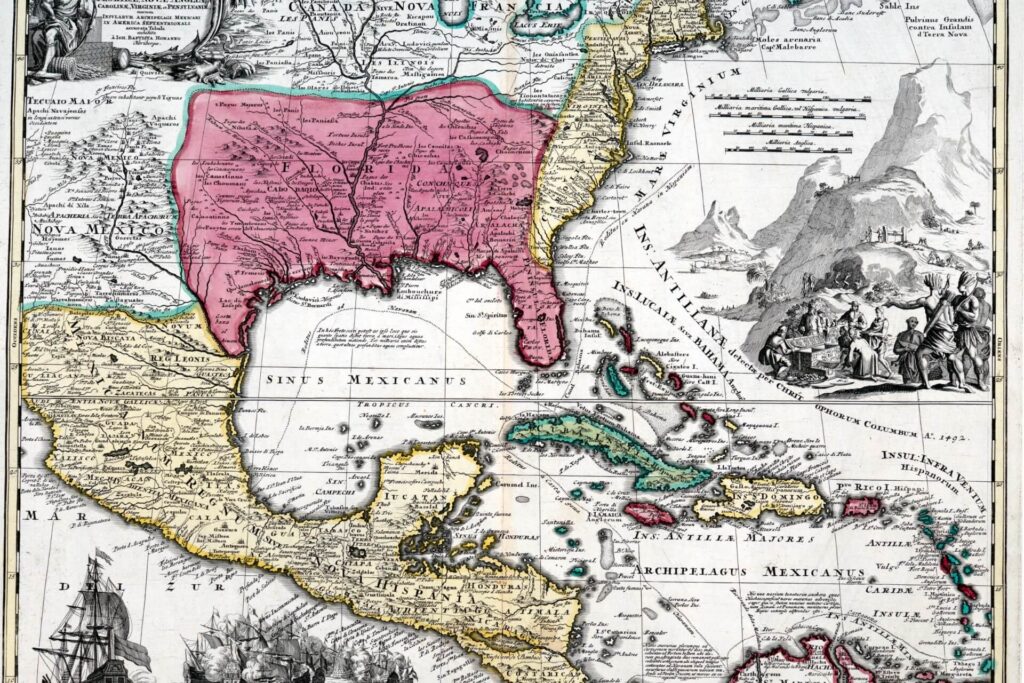Florida was the natural landing place for the exploration of the New World and when the first Europeans landed in the early 16th century, they encountered the Calusa people, the Native American tribe that in those days had settled in the Everglades region in the southwest of the North American continent.
The Calusa people: organization and subsistence
The Calusa people who inhabited Florida in ancient times were organized into a complex and stratified society, composed, as documented by Spanish chroniclers, of “commoners” and “nobles,” in addition to slaves, most of whom were prisoners of war exploited for manual labor. They were ruled by a king and military leader who lived off the labor of the people and administered power.
We know that the Calusa people based their livelihood on fishing using nets made of palm fiber ropes, leaves, bark, and moss. Nets were woven with tools made of bone and shells and had different mesh sizes according to the seasons and how much fish was present. The Calusa were also hunters, mainly of game, although most of the animal protein in their diet came precisely from fish and shellfish, supplemented with gathered wild berries and roots.
Although scholars believe that complex societies like these were primarily agricultural, the Calusa only cultivated small patches, in which they grew chilies, papayas, and gourds, the latter used as floats for fishing.

Fishing for 10,000 people
The tribe was very large and the Calusa soon faced the problem of fish preservation. Being unable to use the common techniques of smoking and salting that were too slow to process and preserve such a large quantity of catch in the sub-tropical climate without it spoiling, the Florida natives devised a system very similar to that used on modern fish farms. They built structures on portions of the estuaries where they could keep the fish alive until it was needed.
The bottoms of these structures – known as watercourts – were lined with shells and sediment and they served as short-term fish storage facilities. The largest watercourt discovered in Florida measured seven basketball courts.
Mound Key, the island of the Calusa, and the home of the king
The Calusa were expert builders as well as excellent fishermen. Historians believe the tribe used sea shells together with bones and charcoal remains as raw materials for building artificial islands. Of these islands, Mound Key, the capital of the Calusa, was the largest. It is also the one that anthropologist Victor Thompson, a professor at the University of Georgia, and his team of researchers explored to better understand its composition and the changes it underwent over time.
Complex analysis procedures, such as core drilling and radiocarbon dating, revealed that the composition of Mound Key is not homogeneous.
According to researchers, the presence of more recent material in the depths of the island instead of on the top, as would be logical to assume, could be explained by the temporary abandonment of the island due to climate changes that would have made fishing difficult. Only at a later stage, Mound Key was repopulated and remodeled with new material.
But that’s not all. According to Thompson, the king’s palace built by the Calusa on the island, was an imposing oval-shaped structure, more than 24 meters long and more than 20 meters wide, that occupied almost the entire area of Mound Key and capable of accommodating up to 2,000 people. Researchers have documented that the palace was built in at least three phases, using raw materials, some of which were imported from overseas, such as lumber. The grandeur of the palace only confirms the hypothesis that the Calusa society was very well developed and organized, with a large workforce that contributed greatly to the construction of the palace.

The end of the Calusa and what remains today
Mound Key palace was a sacred place for the Calusa and ceremonial center when the Spanish first sought to colonize their lands in the early 1500s. Despite attempts by Europeans to convert them to Catholicism, the Calusa resisted and repelled the colonizers but they succumbed to diseases bought to the New World from which they were not immune. They were decimated. The arrival of the Europeans also brought about the secondary consequence of weakening the importance of the tribe in their relationships with the other indigenous North American people whose technology had evolved following the contacts with the Europeans beginning to use firearms, for instance.
Today Mound Key, north of Naples, is a state archaeological park in Florida, with dense vegetation and accessible only by sea, lacking any services. Interactive screens installed along the main paths of the island invite visitors to learn more about the history of Mound Key and the Calusa people.
Currently, researchers are still involved in research and excavations on the island to investigate the history of the Calusa and their relationships with the Europeans.
“There’s a whole story that goes along with this site”, Thompson declared. “It’s a laboratory that allows us to explore many different things, some of which are important to the present and the future and some of which are important to understanding the past.”
Discover Florida’s natural havens and the best beaches on the Gulf of Mexico



